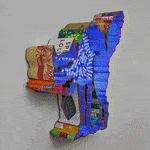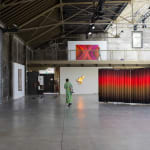-
Open a larger version of the following image in a popup:
 Hallen 4 – Kunstfestival
Wilhelmhallen, Berlin, 2023
Hallen 4 – Kunstfestival
Wilhelmhallen, Berlin, 2023
Courtesy: Hallen 4, Berlin / Photo: © Devid Gualandris, 2023Andrea Bowers
Sabo-Tabby, From Modern Witch House, 2022Cardboard and color changing LED lights, 7 colors98 x 82 x 15.5 cm
38.5 x 32 x 6 inchesB-ABOWERS-.22-0002Further images
Andrea Bowers' neon work, 'Sabo-Tabby, From Modern Witch House,' continues the artist's exploration of historical resistance movements, workers' rights campaigns, and nonviolent civil disobedience. In this artwork, Bowers pays homage...Andrea Bowers' neon work, "Sabo-Tabby, From Modern Witch House," continues the artist's exploration of historical resistance movements, workers' rights campaigns, and nonviolent civil disobedience. In this artwork, Bowers pays homage to the enduring spirit of these movements, drawing a resonant thread through time. She alludes to the iconic depiction of an impassioned black cat—an emblem historically associated with superstition, misfortune, and witchcraft— co-opted by labour folklorists since the 1880s to signify acts of sabotage, covert defiance, and various forms of collective action. This feline symbol's origins are rooted in the Industrial Workers of the World movement, its later evolution intertwining with the ethos of anarcho-syndicalism and eco-activism, encapsulating an enduring legacy of protest and dissent.
Bowers' use of neon underscores her commitment to merging aesthetics with social justice, concurrently venerating influential activists. In “Sabo-Tabby, From Modern Witch House” the artist invokes the historical role of neon as a conduit of communication within both artistic and political paradigms. Simultaneously tapping into neon's historical significance as an instrumentality — a medium rooted in the domains of commercial and industrial signage. Neon takes on renewed purpose, in this work, as a symbol within the artistic lexicon - an embodiment that encapsulates the tenets of defiance, non-violent resistance, and the enduring resonance of symbolic imagery. In this work, Bowers prompts us to reevaluate our perceptions of the path towards emancipatory progress.









